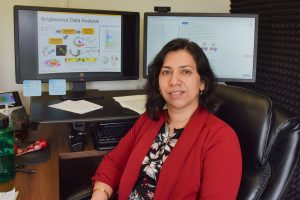How high-performance computing connects brain differences to apnea

By Sophie Rentschler | Bond LSC
A good night’s rest lays the foundation for your daily performance but when a child’s body hampers airflow, that can lead to cognitive problems in their waking lives.
One recent Mizzou study looks at healthy neurological processes and how this differs for patients with obstructive sleep apnea. The study collected a wealth of patient information that can be utilized to help clinicians give a diagnosis quicker in the future.
Yen On Chan, a graduate student in Trupti Joshi’s lab at Bond Life Sciences Center, uses computer models to understand children who have obstructive sleep apnea (OSA). Chan generates interactive visualizations for the lab with computing techniques thanks to his background in computer engineering. His 3D models illustrate the blood-brain barrier to compare patients without OSA, patients with OSA, and patients with both cognitive problems and OSA.

The Joshi lab worked alongside researchers from Marshall University, Abdelnaby Khalyfa and David Gozal, who see patients and collect information from them. The study focused on two structural differences induced by exosomes in children — those affecting the neurological components and the blood-brain barrier.
Exosomes are membrane-bound vesicles responsible for intercellular chatter, communicating signals to cells and carrying proteins between them. Exosomes travel through the blood-brain barrier (BBB). The BBB is a protective shell for the brain, separating the brain’s blood vessels and its cells. This neurological structure serves as a regulator for what molecules pass from blood to the brain, protecting it from harmful toxins and attacks from bacteria and viruses.
Chan entered the biology field with solely a computer engineering background. He was introduced to plant biology, later leading him to studying bioinformatics.

“I enjoy programming and developing interactive visualizations (of the blood-brain barrier) which can help reveal deeper insights and enhance our understanding of its complex structure and functions,” Chan said.
Patient data from Joshi’s bioinformatics lab is so hefty that it must be run on a supercomputer.
“You’re looking at terabytes of information,” said Joshi, faculty lead for translational bioinformatics for NextGen Biomedical Informatics.
Sleep apnea is a disorder where individuals stop breathing during sleep, which may lead to cognitive problems. It has been linked to anxiety, depression and decreased attention span; however, children more often see poor school performance and behavioral disturbances.
“OSA doesn’t just have an impact on sleep,” Joshi said. “It has an impact on systems beyond that.”
Joshi started her career as a clinician but said she entered the field of bioinformatics around the time the human genome was discovered in the early 2000s, and she has used data to explore a wide array of areas from soybeans to human diseases.

That data led scientists in this study to conclude that exosomes from patients with OSA — whether it’s those without or with a cognitive deficit — carry out different functions than in those without OSA. Studying exosomes in children with OSA alongside the permeability of the blood-brain barrier can tell researchers how these neurological structures are being disrupted.
Joshi said studying that impact can allow for more personalized therapeutics. She added that because the blood-brain barrier and the neural system is so central to controlling so many activities, it’s integral to understanding this disorder.
“When the permeability (of the BBB) is increased, you have a lot more traffic of molecules going in and out,” Joshi said.
Wealth of data leads to personalized therapeutics
“When you have multiple conditions, you have to be able to overlap it, integrate it and see the differences,” Joshi said.
Chan makes that possible. Joshi said her collaborators are always pleased to find out that Chan is involved since he can write his own code, analyze data, and create his own data visualization tools.
“He can address the entire spectrum,” Joshi said about Chan’s contributions to the bioinformatics lab.
The future of this research lies within the wealth of data available to analyze with computing.
“The beauty of this large amount of data is with computer science and informatics, you can roll it into deep learning (artificial intelligence) models,” Joshi said.
Joshi said this modeling “is going to be helpful for clinicians because now they are better positioned to provide the best therapy that the kid needs, rather than having to wait 10 years later and then finding out.”
This study was published in March 2025 in the journal Experimental Neurology. Read more about it in Mizzou’s School of Medicine release.
This study was supported in part by grants through the Joan C. Edwards School of Medicine at Marshall University, the Missouri Department of Health and Senior Services, and the National Science Foundation.

